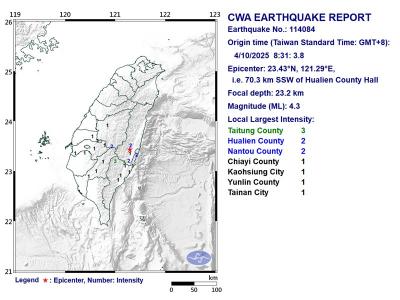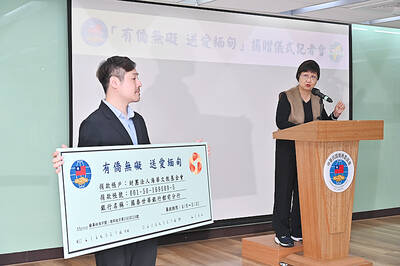The nation’s 4G telecoms have finished building and testing a public warning system (PWS) for natural disasters, the National Communications Commission (NCC) said yesterday.
People can start receiving disaster-warning messages from the PWS on July 1 after the National Science and Technology Center for Disaster Reduction (NCDR) finishes its part of the testing, by the end of June, it added.
The system was proposed in 2011, when Japan was severely hit by a magnitude 9.0 earthquake and a subsequent quake-induced tsunami.
NCC spokesperson Yu Hsiao-cheng (虞孝成) said the commission is to upload a list of mobile phones that are able to receive the disaster-related messages on its Web site, which would be available for the public to view on Sunday.
Yu said the telecoms had been able to deliver disaster-warning messages, but they were only able to send a maximum of 2,000 messages per minute.
He said the PWS utilizes cell broadcast technology, which can simultaneously send more than 100,000 messages in targeted regions within seconds.
Yu said the service, which would be offered free of charge to mobile phone users, is only possible via a 4G service. As such, people with mobile phones that can only process 2G service would not be able to receive the messages from the PWS, he said.
Subscribers of 2G services can still receive the disaster-warning messages through the previous method, he said.
Yu said the NCDR first receives messages from the devices detecting natural disasters or from agencies monitoring the occurrences of these disasters, which are then processed at the cell broadcast entity.
He said these messages are then converted into readable formats and sent to the telecoms, which subsequently send them to their service subscribers that might be affected by a certain natural disaster through their base stations installed nationwide.
Yu said that telecoms have finished the tests of PWS from their ends to their subscribers, with the test results showing that the time needed to send the message could take from two seconds to more than 10 seconds.
“The goal is that the NCDR would complete building and testing their part of the PWS by June 30,” Yu said. “The total time needed to transmit the message from the NCDR to the mobile phone users would have to be determined based on how fast the NCDR can process information from disaster-monitoring agencies or devices.”
The NCC said mobile phones certified by the commission after March 1 are supposed to be able to receive the messages disseminated through cell broadcast technology.
For mobile phones certified before March 1, manufacturers are asked to upgrade their systems so that users can receive the message from the PWS as well.
A telecom service expert said the nation’s telecoms have established public warning systems for 2G, 3G and 4G service users. While 4G users can receive messages from the PWS while they are on the phone or the Internet, 3G users cannot receive messages if they are sent when they are talking on the phone or are online. However, 2G users can only receive text messages through the mobile phone network.

Taiwan is stepping up plans to create self-sufficient supply chains for combat drones and increase foreign orders from the US to counter China’s numerical superiority, a defense official said on Saturday. Commenting on condition of anonymity, the official said the nation’s armed forces are in agreement with US Admiral Samuel Paparo’s assessment that Taiwan’s military must be prepared to turn the nation’s waters into a “hellscape” for the Chinese People’s Liberation Army (PLA). Paparo, the commander of the US Indo-Pacific Command, reiterated the concept during a Congressional hearing in Washington on Wednesday. He first coined the term in a security conference last

A magnitude 4.3 earthquake struck eastern Taiwan's Hualien County at 8:31am today, according to the Central Weather Administration (CWA). The epicenter of the temblor was located in Hualien County, about 70.3 kilometers south southwest of Hualien County Hall, at a depth of 23.2km, according to the administration. There were no immediate reports of damage resulting from the quake. The earthquake's intensity, which gauges the actual effect of a temblor, was highest in Taitung County, where it measured 3 on Taiwan's 7-tier intensity scale. The quake also measured an intensity of 2 in Hualien and Nantou counties, the CWA said.

The Overseas Community Affairs Council (OCAC) yesterday announced a fundraising campaign to support survivors of the magnitude 7.7 earthquake that struck Myanmar on March 28, with two prayer events scheduled in Taipei and Taichung later this week. “While initial rescue operations have concluded [in Myanmar], many survivors are now facing increasingly difficult living conditions,” OCAC Minister Hsu Chia-ching (徐佳青) told a news conference in Taipei. The fundraising campaign, which runs through May 31, is focused on supporting the reconstruction of damaged overseas compatriot schools, assisting students from Myanmar in Taiwan, and providing essential items, such as drinking water, food and medical supplies,

Prosecutors today declined to say who was questioned regarding alleged forgery on petitions to recall Democratic Progressive Party (DPP) legislators, after Chinese-language media earlier reported that members of the Chinese Nationalist Party (KMT) Youth League were brought in for questioning. The Ministry of Justice Investigation Bureau confirmed that two people had been questioned, but did not disclose any further information about the ongoing investigation. KMT Youth League members Lee Hsiao-liang (李孝亮) and Liu Szu-yin (劉思吟) — who are leading the effort to recall DPP caucus chief executive Rosalia Wu (吳思瑤) and Legislator Wu Pei-yi (吳沛憶) — both posted on Facebook saying: “I